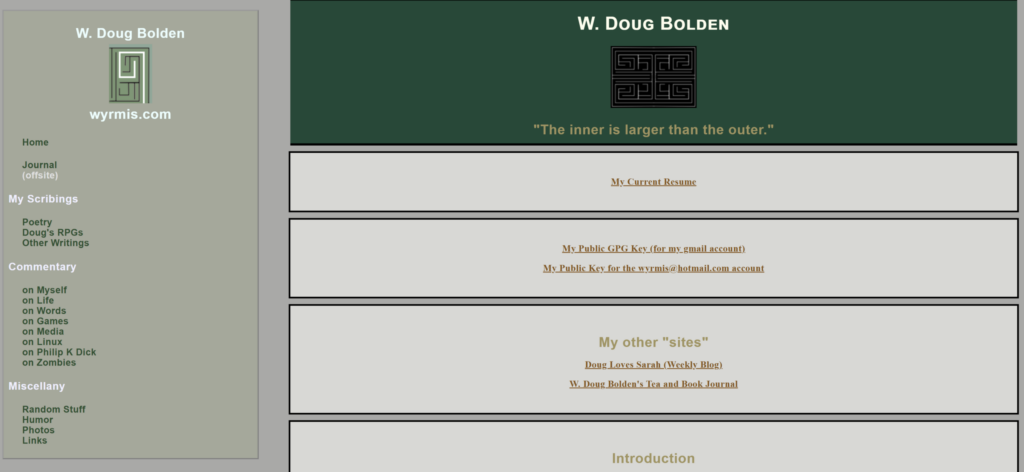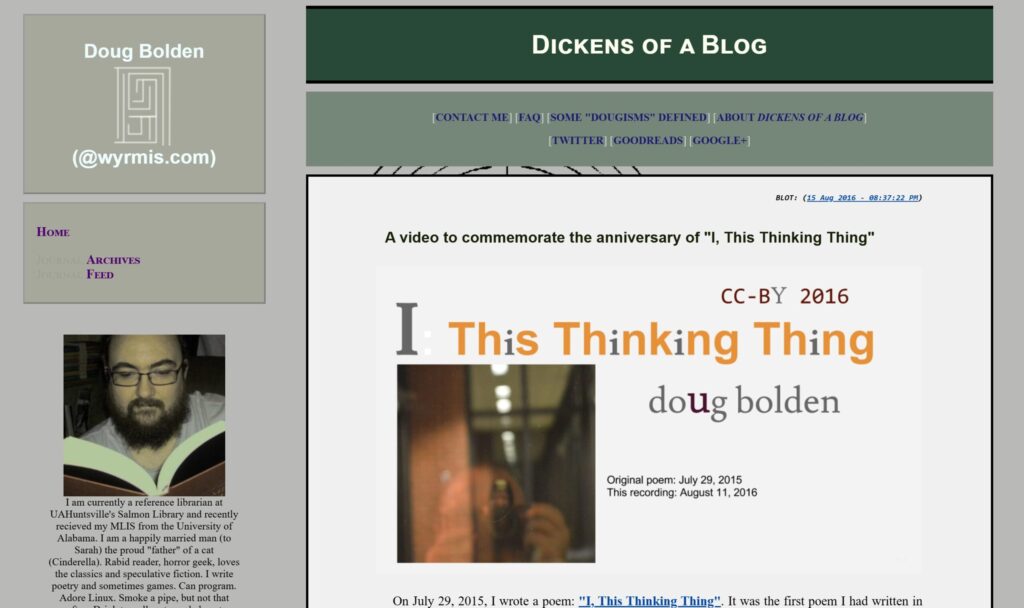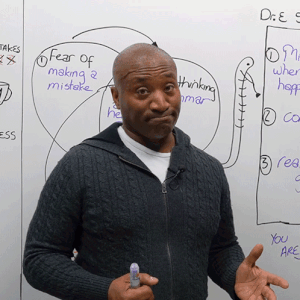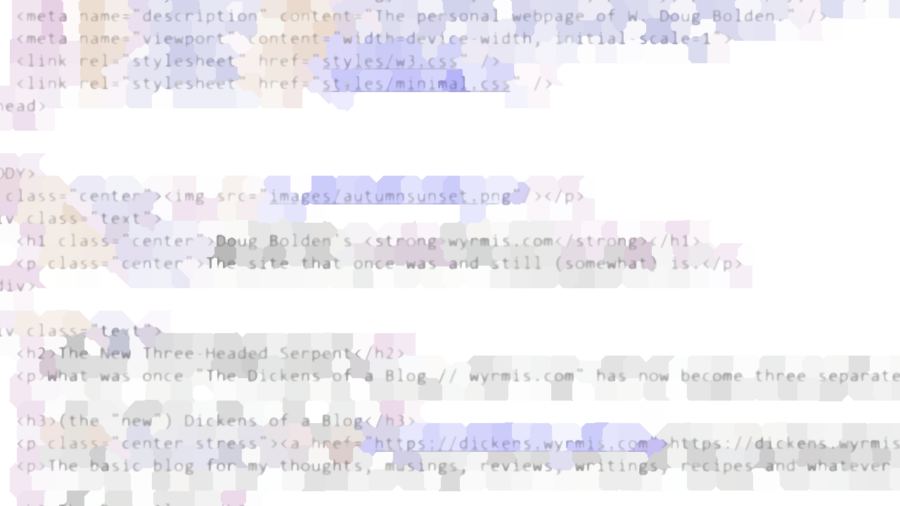In the first post on this blog, I talked about the updates to the “old” wyrmis.com and how I consider this to be a continuation — eight-years later — of the initial project which that blog & website represented. Which was in, in principle, a continuation of various blogs and websites that I had been working on for years.
BY THE WAY: I plan on having a part two to this post, more or less, more of a trip down memory lane type thing. I have screenshots and everything. I’ll come back and link it when I post it. If I post it, I suppose, but I think I will. I’m old enough now that reminiscing is nice.
Here is what the old site looked like around the time it was first launched (I think this screenshot would be more in the 2007-era after it had already gone through some evolution):

Then, around the time it was abandoned (2016), it looked more like:

In that decade in between, while the general color schemes and rough layout had remained the same, the back-end had grown a lot more complicated — involving multiple custom scripts in Python and PHP and a more complicated file structure — while also growing more out of date with modern web practises.
To put it in perspective, while that version was well after the general “Blogging” trend had started, it was an outgrowth of a website that had actually started back in 1997. One of its core issues was that it was dragging along a lot of content and structure as it became less and less a 90’s style website and more a 2000’s era blog.
If you note, the first image shows the “journal” section was off-site — first on Livejournal and latter on Blogger — because it wasn’t until later an adequate but generally poor blogging “software” was integrated by myself into the existing page. By “integrated,” I mean that I coded it and then spent entirely too long making it act like the rest of the website.
If there is one lesson you take from this: Make your tools work for you, do not work for your tools. I violated that principle. It shows.
The Problem(s) As It Stands
There are a few problems with what to do with the old site. The main ones to be:
- The HTML, CSS, PHP, Python, Images and essentially all the rest are a hodge-podge of 1997-2017. Twenty years of various web eras.
- Even though the bulk of the site was at least partially updated and badly polished throughout the 2010s, enough issues remain that made it nearly impossible to edit as-is into anything truly fitting a post-2010 website.
- In fact, some of the multitudinous layers of bandages actually hurt the repair because different eras of pages have different enough code that anything but a hand-coded fix is likely to break other portions.
- A lot of the content would only be saved for purely archival purposes (we’ll dub this The Librarian Principle). Links are likely broken and fixing them would potentially require longer than any value would be added for anyone. Timely content is no longer near timely. Trends and discussions are based on their era which is not that far ago but over a decade.
- The contrast of The Librarian Principle is The Embarrassment Principle. Past-Doug was a weird boy. Some of the things typed up because I thought it was funny at the time are decidedly not. A few of the points for which I argue vehemently are no longer anything like a stance I would take. By the time we get to the wyrmis.com-era, that is less true, but…man. I think I might make a third part for this. One where I lecture myself. It’s not quite suited to going into any more for this post.
Is It Worth Solving?
In a word…

I don’t really know. Like I said, I just volunteer here. At least some of it seems worthy. A few bits. Possibly even the majority, really.
I need to write a script that takes all the pages on the site and then just randomly picks five of them to read. See if the Librarian beats out the Embarrassed via dice roll.
The truest answer I can make at this time is that the best solution forward is to “fix” the big pieces and then figure out which of the smaller individual pieces to retain.
It feels dishonest to delete all the portions with which I now disagree or dislike, so I’ll work on something like a balance. A triage. Some will get instantly deleted if they simply do not fit (“fit” is doing some heavy lifting, take it as you will), are too time-locked to be worth saving, or any other heavy complaint I might have. Some will get instantly saved and enshrined into place as a part of my decades online. Some will get updated and possibly ported over here.
I think the lines I’ll draw in the sand is that stuff that is good enough to stay as is will stay where it is (Type A), stuff that could be better might get brought over to this blog and updated (Type B), and stuff that I don’t feel like saving will either join with Type A with minimal fixing or simply disappear. This means the old site/blog will have a mix of highs and lows with the middle joining my new writings.
A hint towards verisimilitude actually masking a large scale “reclamation” project.
The Mechanics of It All
Going back up The Problem(s) As It Stands, the first bullet point and the sub-bullets are the meat of the mechanical issues. There are two variations of solution:
- Develop a new schema and then port the old bits into the new bits.
- Strip the old schema off and just retain the core bits.
I am currently opting for #3: a bit of both. The new schema is largely just a minimal CSS and jQuery working frame that delivers the text in a readable — both human-readable and machine-readable — manner (albeit fairly bland) but otherwise ignores much of the intricacies of what came before. Headers {e.g., H1, H2} and body content {e.g., P, LI} items will be mostly HTML-standard with a few variations.
In practical terms, this means I am:
- Taking the old page (currently one at a time)
- Replacing the HEAD content with a newer, improved version.
- Deleting all the old menu, footer, counter, and similar code not in the main body.
- Replacing the title/banner portion with a simplified version.
- Adding in new DIVs that act as placeholder for repeating content {e.g., menus, site-wide idents} and then using jQuery to handle that.
- Generally going through the body and making sure things mostly work. Deleting a few portions that no longer fit the criteria above.
- Uploading that to the site.
- In some cases, adding redirects to “close” a portion of the site or to make up for things that will now be missing.
- Eventually, going through and deleting the pages that neither fit into Types A or Type B.
I have worked out the stuff to get the new-schema pages and the site as a whole into HTTPs. And to be more responsive. In theory, I can work on a script that will do #2, #3, and #5 for me though I’ll likely have to do the rest by hand.
I also will be adding this post as at least a temporary link to show up near the bottom to explain to folks why things are happening. Ironically, this will only show up on pages I have partially fixed but so it goes.
Why “Reclamation”?
Just to wrap this up: why am I calling it a reclamation?
It just feels right as a term. There were years of myself in that website and blog. Lots of memories. Lots of creative output. In theory it could stay as is — online or just on my personal storage devices — but I like the idea of retaining some of it. More than that. Making it usable, again. Giving credit to past-Doug where credit is due. Also holding my past-self to a higher standard.
I am me because of his idiocy. I just wish someone had fussed at him like I am about to fuss at myself.
There is also a complicated side-aspect that some of those posts have been taken a bit out of context or been copied over and all sorts of stuff that can happen to websites across decades. By cleaning it up and improving its general SEO-ness, it helps to establish it more as a part of its own record.
What Kind of Time-line Are We Looking At?
As for the question of how long will this take? I have only one answer…


